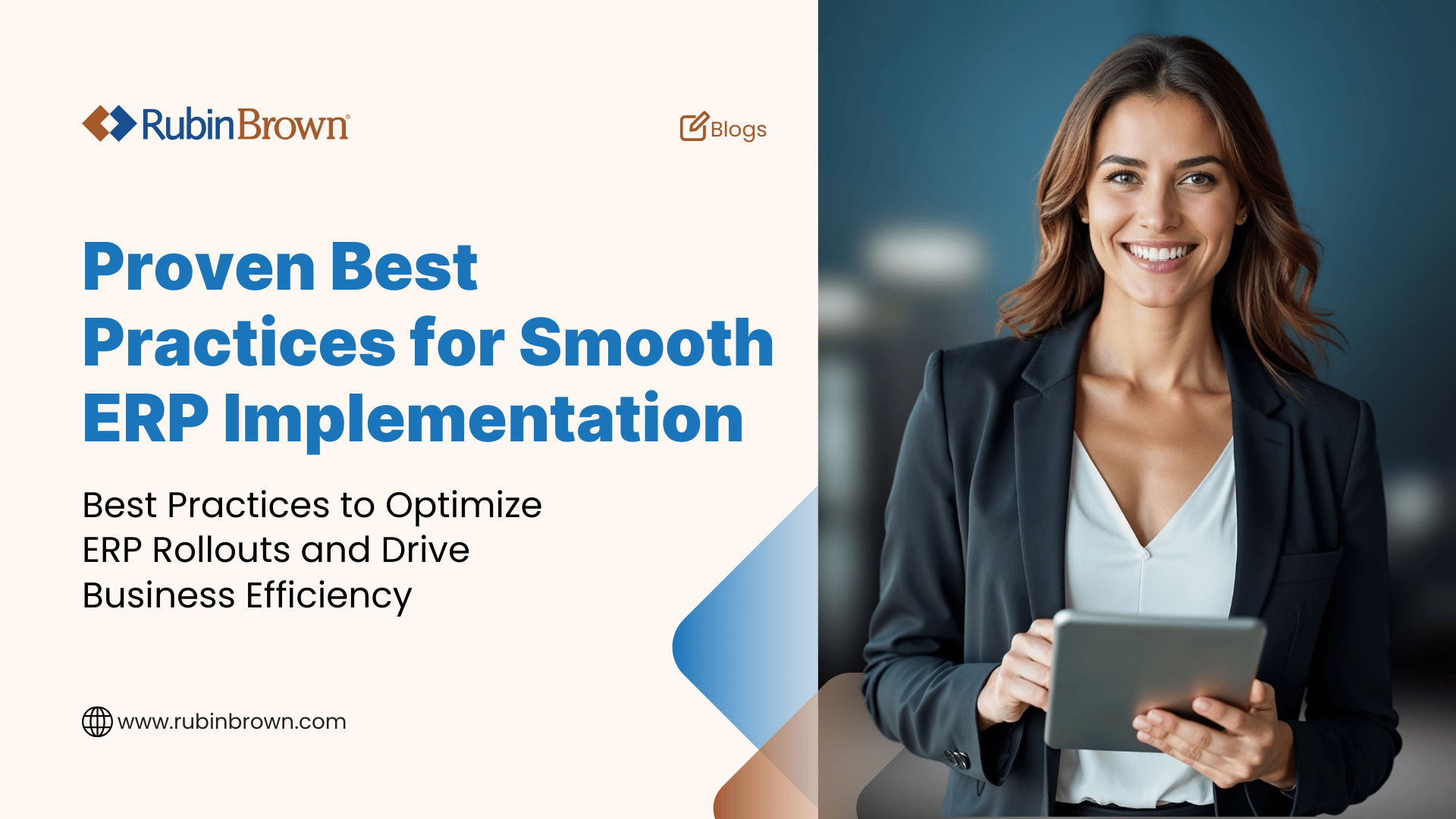Key ERP Implementation Best Practices Every Business Should Follow
Did you know that 50% of ERP implementations fail initially due to poor planning and execution? For organizations looking to streamline operations...
10 min read
Admin
:
Jun 10, 2025 2:04:25 PM

How do you align financial control, operational workflows, and data governance across multiple business entities during an ERP rollout? For organizations with multiple legal structures, locations, or lines of business, deploying an Enterprise Resource Planning (ERP) system introduces organization-wide changes. These changes impact process standardization, reporting frameworks, compliance, and user responsibilities, all of which require early stakeholder alignment and a clear design that reflects the interdependencies between business units for a successful multi-company ERP implementation.
According to research, 66% of organizations report an improvement in operational efficiency after implementing an ERP. Achieving similar outcomes from your ERP system, whether cloud-based or traditional, requires deliberate planning and coordination. This is especially true where intercompany transactions, regulatory variations, and operational models differ across your various entities. This guide outlines a structured ERP implementation approach, offering actionable steps for establishing a functional foundation, preparing resources, executing system rollouts, and supporting long-term performance across your entire structure as you manage multiple entities.
The initial phase of any ERP implementation project is pivotal, particularly for multi-entity operations. This strategic blueprinting stage establishes the foundation for the entire implementation process. It includes a detailed review of your existing corporate structure, precise mapping of system capabilities to your unique business requirements, and a proactive approach to business process reengineering. Addressing these elements accurately from the start will significantly influence the project's path toward a successful multi-company ERP implementation.
A transparent view of your corporate architecture is the critical first step in a multi-company ERP implementation. Clearly chart the relationships between the parent company and its various business units or subsidiaries, detailing their interactions and reporting structures. This clarity verifies that the ERP system design accurately reflects how your entire organization functions, preventing misalignments. ERP software requirements related to master data, security, intercompany transactions, organizational structure, and administration all stem from this definition.
Analysis of operational control across your multi-entity operations—whether centralized, decentralized, or hybrid—directly impacts ERP configuration and how the new ERP system will manage workflows. The geographical distribution of your entities, whether domestic or international, introduces additional layers, including multiple currencies, diverse accounting regulations, and varied compliance mandates, all of which are crucial for selecting an appropriate ERP. Ultimately, your business structure profoundly influences specific ERP software needs, such as requirements for different costing methods or how the ERP team will manage intercompany buy-sell relationships within the new system.
Once your corporate structure is defined, translate this into high-level ERP system capability requirements for your ERP implementation project. This mapping exercise affirms that the chosen ERP software and its configuration align with your organization's architecture and operational model. Common ERP configurations include single financial/single operation for simpler entities, or multiple financial/single operation for organizations with unified manufacturing but diverse sales offices that must handle varied currencies and tax laws.
Other configurations, such as single financial/multiple operations, suit complex organizations with a single legal entity but distinct operational units requiring different business process support from the ERP system. For multinational conglomerates, a multi-financial, multi-operation ERP system configuration is typically the most suitable; it emphasizes centralized administration, intercompany transactions, consolidated reporting, and data sharing. Key considerations for such international, multi-entity operations include the effective management of multiple currencies and adherence to localization and compliance regulations with your chosen ERP solution.
Business Process Reengineering (BPR) is integral to reshaping business operations for effective integration of new ERP systems across multiple entities. BPR involves a fundamental reevaluation of core business process workflows to achieve significant performance improvements. For an ERP implementation project to yield maximum benefits, BPR activities should commence before software selection and continue throughout the implementation process.
A critical aspect of BPR is a thorough analysis of current workflows within each business unit and across the entire organization. This identifies bottlenecks, redundancies, and areas for harmonization. Tailoring business process workflows to align with the chosen ERP system structure, rather than heavily customizing the ERP software to fit outdated processes, is key. Adoption of ERP best practices, such as sensible process standardization and fostering a culture of continuous improvement, is central to successful Business Process Reengineering and a successful ERP implementation.
With the strategic blueprint established, the second phase of your multi-company ERP implementation project focuses on assembling necessary resources and preparing the groundwork. This includes building a capable ERP project team, developing a comprehensive resource management plan and implementation budget, creating a robust ERP data migration strategy, and selecting the right ERP software and implementation partner.
The strength and expertise of your ERP project team are fundamental to a successful multi-company ERP implementation. Clearly define essential roles: a dedicated Project Manager, application analysts, developers, QA testers, and key users from all impacted departments and entities. Prioritize top performers with deep process knowledge and strong communication skills for this implementation team.
Develop a comprehensive resource management plan that includes realistic time commitments. Core team members may dedicate approximately 50% of their time, which necessitates planning for backfilling. The implementation budget for your ERP implementation requires careful forethought for internal personnel, external consulting, hardware, vendor fees for system configuration, and comprehensive ERP training. Acknowledging labor as a significant component of ERP implementation costs allows for accurate financial resource planning.
Migration of data from legacy systems into a new ERP system poses a significant challenge, particularly when managing multiple entities with distinct databases. A meticulously planned data migration strategy is essential for a smooth transition and data integrity in your new system. Key phases include the thorough assessment, cleansing, and validation of existing ERP data from all sources.
Plan and execute multiple test migrations to refine the process, identify potential issues, and validate mappings before the actual cutover. Successful strategies include establishing a clean data baseline, implementing consistent data handling protocols, and conducting thorough testing at each stage of the ERP data migration. Training end-users on data quality standards within the new ERP system is also essential for long-term success and a successful ERP implementation.
The selection of the right enterprise resource planning system is a decision with long-term implications for your business operations. For multi-entity operations, the chosen ERP software must effectively handle intercompany transactions, financial consolidation, and localized compliance. It should also offer a flexible ERP configuration framework adaptable to the varied system needs of different business units, while maintaining a cohesive core system.
The value of an implementation partner with proven experience in complex multi-company ERP implementation project scenarios is immense. An experienced ERP partner brings technical skills, strategic guidance, and robust project management methodologies. When you vet potential ERP software vendors and partners, ask about their experience with organizations of your size and complexity, their methodology for ERP system implementation, and how they handle data migration, customization governance, and ERP training in a multi-entity context.
With planning complete and resources assembled, the ERP implementation project enters its core execution phase. This stage of the ERP implementation process is where the new ERP system begins to materialize. Implementation success hinges on a structured methodology, robust communication across all stakeholder groups within your multiple entities, and careful management of standardization versus necessary customization. Effective project management keeps the ERP project on schedule.
Adoption of a deliverables-based methodology is highly recommended for the core ERP implementation process. This approach breaks down the multi-company ERP implementation project into smaller, clearly defined, and measurable deliverables. Each deliverable has a specific scope, timeline, and acceptance criteria, making it easier to monitor progress.
This structured execution provides clarity for the ERP implementation team, allowing for efficient progress tracking. Early identification of accomplishments and shortfalls enables timely intervention and corrective action. A deliverables-based methodology facilitates course correction with minimal disruption if the ERP project drifts, a vital aspect for complex ERP implementation projects.
A proactive communication ecosystem is crucial throughout the ERP implementation process, particularly as it affects the entire organization across multiple entities. The Project Manager should provide regular updates to senior management on the project's status, any issues, and the implementation budget. Core ERP implementation team members must communicate effectively with end-users about how the new system will impact their jobs.
Keeping all stakeholders aligned means fostering two-way communication through regular meetings, updates, and Q&A sessions. Senior management plays a key role when they reaffirm support for the ERP implementation project and its strategic importance. Consideration must also extend to communication with external stakeholders if their business process interactions are affected by the new ERP system.
A critical strategic decision during the ERP implementation process for organizations with multiple entities is finding a balance between core process standardization and entity-specific customization of the ERP software. Standardization offers simplified training, easier maintenance, improved ERP data consistency, and potentially lower ERP implementation costs. However, rigid imposition of standardization without considering legitimate local requirements can lead to user resistance.
Excessive customization adds complexity, increases initial ERP implementation costs and ongoing maintenance, and can complicate future upgrades of the ERP platform. Develop a clear governance model to evaluate and approve any necessary customization requests. The aim should be to standardize wherever possible and customize only when a compelling business justification aligns with the overall strategy for effectively managing multiple entities within a single ERP solution.
As the ERP implementation project progresses, focus shifts to preparing the entire organization for change and ensuring a smooth transition to the new ERP system. This fourth phase is crucial for the success of ERP implementation. Driving user adoption through effective training and change management, coupled with meticulous testing and thorough go-live preparedness, is paramount when implementing an ERP across multiple entities.
User adoption is a primary driver of implementation success when an ERP system is implemented across multiple entities. Develop comprehensive, tailored, and role-based ERP training programs specific to user roles and responsibilities within each business unit. Generic ERP training is rarely effective for a new ERP system.
Strategic change management is pivotal for guiding the organization through the transition. This requires clear communication about the reasons for change, the benefits of the new ERP, and its impact on employees. Involving user representatives in the planning and testing stages helps anticipate adoption challenges and enables them to act as advocates for the new system.
Meticulous testing is non-negotiable before a new ERP system goes live, especially in a multi-company context. Implement comprehensive testing cycles, including unit testing, ERP integration testing, and, critically, User Acceptance Testing (UAT) involving end-users from all relevant entities. UAT confirms the ERP system effectively supports daily tasks and meets agreed-upon ERP software requirements.
Develop a detailed go-live plan that outlines all activities, responsibilities, and timelines for the cutover from legacy systems to the new ERP. For multi-entity operations, this approach may involve a "big bang" rollout (all at once) or a phased rollout. Establish robust contingency plans to address potential issues during cutover, ensuring key ERP team members and vendor support are readily available to prevent implementation failures.
Work with your new ERP system continues well after it goes live. Phase five of the multi-company ERP implementation focuses on sustaining success through post-implementation support, ongoing optimization, and a commitment to continuous improvement. This guarantees that the ERP investment continues to deliver value and adapts to the evolving needs of your multiple entities.
Once the new ERP system is operational, the focus shifts to sustaining operational excellence and providing user assistance. Establish a dedicated support team or clear processes for resolving issues and providing user assistance across all entities. This might involve an internal help desk or an ongoing support agreement with your ERP software vendor for your ERP solution.
Systematically gather user feedback from all entities to identify areas for improvement and additional ERP training needs. This ongoing assistance also includes proactive measures, such as monitoring system logs and applying necessary patches to the core system. Effective post-go-live support helps ensure minor issues do not escalate and the entire organization benefits from its ERP investment.
An enterprise resource planning system in a dynamic multi-company environment requires ongoing system performance monitoring and continuous improvement. Continuously analyze ERP system performance against established Key Performance Indicators (KPIs) defined during the initial ERP implementation plan. Regular reporting on these KPIs will highlight areas for optimization of the ERP platform.
Refine business process workflows, system reports, and utilities based on operational insights and user feedback. Make sure the ERP system remains agile and adapts to future changes in your multi-entity operations, such as growth, acquisitions, or new market entries. A proactive approach to continuous improvement guarantees your ERP investment remains a strategic asset.
After the new ERP system has been operational for a period (e.g., 6-12 months), conduct a formal post-implementation review. This review assesses the success of the ERP implementation project in achieving its original goals and quantifies the benefits. This step is crucial for accountability and capturing lessons learned from implementing an ERP system.
The review should measure achievements against predefined targets, such as improved operational efficiency or streamlined financial reporting. Calculating the Return on Investment (ROI) for a successful multi-company ERP implementation involves comparing the total ERP implementation costs against the financial benefits. Documenting lessons learned helps refine project management methodologies for future initiatives, thereby contributing to the long-term success of ERP implementation.
Establish consistent, visible executive sponsorship across all involved business units to provide authority, champion change, and resolve conflicts. Complement this with a clear governance structure, including a cross-entity steering committee, and a comprehensive project plan that outlines roles, responsibilities, and scope control. This foundational leadership and oversight are critical for guiding the multi-company ERP implementation project effectively.
Meticulous upfront planning forms the backbone of a successful ERP deployment. This includes a clear strategy for managing master ERP data centrally while accommodating local needs, as well as detailed plans for data migration from legacy systems. This blueprint should also define how the core system and any necessary customization will function within the unique operational context of every business unit.
Discipline in execution is key. This involves adhering to your project plan and conducting thorough, entity-specific testing cycles—including unit, integration, and User Acceptance Testing (UAT). Rigorous quality assurance at each stage validates that business process workflows and ERP data are correct for each entity, preventing costly post-launch implementation failures.
Successfully implementing an ERP system requires adequate and strategic resource allocation, encompassing dedicated internal team time and a realistic budget for the ERP that includes all potential implementation costs. Recognize when to supplement your internal capabilities by engaging experienced ERP implementation services from partners who understand the specific nuances of multi-company deployments and can provide critical expertise and guidance.
Implementing an ERP system for multi-entity organizations demands detailed planning, a disciplined approach to business process design, and consistent stakeholder alignment throughout the ERP implementation project. Each phase—from strategic blueprinting and resource planning to system rollout and post-launch optimization—serves a specific purpose in building long-term ERP system stability and operational consistency across your enterprise. This is key to the successful implementation of an ERP.
Organizations that complete their ERP implementation with entity-specific design considerations enhance cross-functional coordination, minimize manual workarounds, and improve reporting accuracy. These results require execution discipline, not just during the planning and launch of the new ERP, but through ongoing support and system refinement of their enterprise resource planning solution. A well-executed management plan for your multi-company ERP implementation project is essential.
RubinBrown supports clients through each stage of the ERP implementation. Our ERP implementation team brings structured methodologies, experience with diverse system configurations, and practical implementation services expertise to help organizations complete ERP projects with clarity and control. To align your ERP system with your multi-entity structure and operating goals and drive a successful multi-company ERP, contact RubinBrown for a consultation.

Did you know that 50% of ERP implementations fail initially due to poor planning and execution? For organizations looking to streamline operations...

1 min read
Is your ERP system still doing its job? Most companies don’t know until it’s too late. The most expensive mistake in enterprise resource planning...

ERP implementations are rarely a straightforward process. In fact, nearly 50% of ERP projects fail on their first attempt, often due to poor...